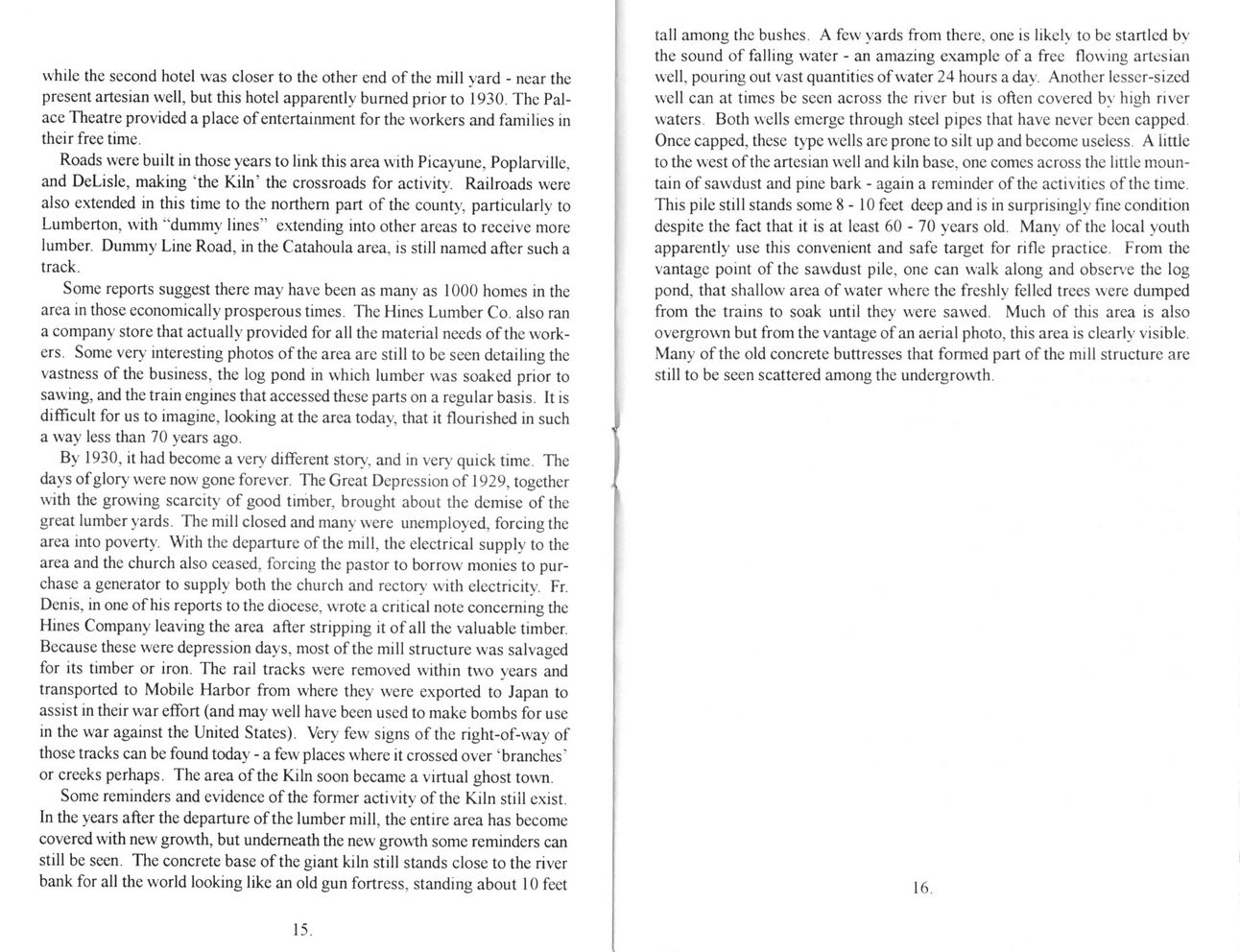This text was obtained via automated optical character recognition.
It has not been edited and may therefore contain several errors.
while the second hotel was closer to the other end of the mill yard - near the present artesian well, but this hotel apparently burned prior to 1930. The Palace Theatre provided a place of entertainment for the workers and families in their free time. Roads were built in those years to link this area with Picayune, Poplarville, and DeLisle, making ?the Kiln? the crossroads for activity. Railroads were also extended in this time to the northern part of the county, particularly to Lumberton. with ?dummy lines? extending into other areas to receive more lumber. Dummy Line Road, in the Catahoula area, is still named after such a track. Some reports suggest there may have been as many as 1000 homes in the area in those economically prosperous times. The Hines Lumber Co. also ran a company store that actually provided for all the material needs of the workers. Some very interesting photos of the area are still to be seen detailing the vastness of the business, the log pond in which lumber was soaked prior to saw ing, and the train engines that accessed these parts on a regular basis. It is difficult for us to imagine, looking at the area today, that it flourished in such a way less than 70 years ago. By 1930, it had become a very different story, and in very quick time. The days of glory were now' gone forever. The Great Depression of 1929, together with the growing scarcity of good timber, brought about the demise of the great lumber yards. The mill closed and many were unemployed, forcing the area into poverty. With the departure of the mill, the electrical supply to the area and the church also ceased, forcing the pastor to borrow monies to purchase a generator to supply both the church and rectory with electricity. Fr. Denis, in one of his reports to the diocese, wrote a critical note concerning the Hines Company leaving the area after stripping it of all the valuable timber. Because these were depression days, most of the mill structure was salvaged for its timber or iron. The rail tracks were removed within two years and transported to Mobile Harbor from where they were exported to Japan to assist in their war effort (and may well have been used to make bombs for use in the war against the United States). Very few signs of the right-of-way of those tracks can be found today - a few places where it crossed over ?branches? or creeks perhaps. The area of the Kiln soon became a virtual ghost town. Some reminders and evidence of the former activity of the Kiln still exist. In the years after the departure of the lumber mill, the entire area has become covered with new growth, but underneath the new growth some reminders can still be seen. The concrete base of the giant kiln still stands close to the river bank for all the world looking like an old gun fortress, standing about 10 feet 15. tall among the bushes. A few yards from there, one is likely to be startled by the sound of falling water - an amazing example of a free flow ing artesian well, pouring out vast quantities of water 24 hours a day. Another lesser-sized well can at times be seen across the river but is often covered by high river waters Both wells emerge through steel pipes that have never been capped Once capped, these type wells are prone to silt up and become useless. A little to the west of the artesian well and kiln base, one comes across the little mountain of sawdust and pine bark - again a reminder of the activities of the time. This pile still stands some 8 - 10 feet deep and is in surprisingly fine condition despite the fact that it is at least 60 - 70 years old. Many of the local youth apparently use this convenient and safe target for rifle practice. From the vantage point of the sawdust pile, one can walk along and observ e the log pond, that shallow area of water where the freshly felled trees w ere dumped from the trains to soak until they were sawed. Much of this area is also overgrown but from the vantage of an aerial photo, this area is clearly visible. Many of the old concrete buttresses that formed part of the mill structure are still to be seen scattered among the undergrowth. 16.

Annunciation Church Kiln 011